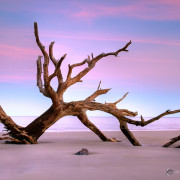Depth & Distractions in Landscape Photography Composition
The “rules” of photography composition are time-tested strategies that help us place the elements in our scene in a way that will convey the story of the location to our viewers. But these rules are of slightly less help when we are trying to make decisions about what to keep and what to eliminate from your landscape photography composition. Here are three techniques that will help you when you are looking through your camera and deciding what elements to include in your photograph.
What is my story?
When I am trying to set up a shot and begin to struggle with photography composition, I always pause and ask myself 2 questions:
- What is My Subject?
- What is The Story that I want to tell with my photography composition?
These questions help me narrow down what I want to include in the landscape photo. If an element of the scene is part of the subject or if supports the subject or the story, then it obviously should be included. I actually find it easier to eliminate items! If they don’t support the subject or the story, then I try to exclude them. By taking this approach, I essentially eliminate anything that is distracting and I’m left with a distilled down version of the scene that strongly communicates my story. This makes it clear to the viewer what the photograph is about and is more likely to engage them when they don’t have to work around distractions.
In the image from the Amish country above, a large cemetery with headstones that lies just to the right of the frame was eliminated, because it had nothing to do with the story of the Amish buggy and the lovely fall day. The horse drawn wagon was carefully placed on the right upper third power point.
Including Elements to add Depth
When we photograph, we are recording a 3-dimensional scene with a 2-dimensional medium. Because of this, it can be difficult to convey a sense of depth in an landscape photo. When deciding what to include or exclude from a landscape photography composition, it can be effective to include something in the foreground to help establish a sense of depth. Strive for a definite foreground, middle and background, particularly when your scene is vast. Be cautious to avoid overlapping or merging the layers in the scene, as this will reduce that sense of depth.
In the above image of the Oregon Coast, I was careful to include a foreground rock as well as the large expanse of sand as the middle layer. Note that the rock does not merge with the background or the reflections, and the viewer has the impression that the distant rocks are far away and the scene is quite large. I excluded a tide pool that was just in front of the foreground rock, because it felt like a distraction and seemed to stop my eye as I tried to work my way from the front to the back of the image.
Eliminate Distractions
As important as what to include in your photograph is what to eliminate. Try to look around the scene and position your camera to eliminate anything that takes away from the subject and its story. This is something that isn’t easy at first because we tend to only notice the thing that caught our eye when we first decided to take the shot. You must train yourself to look around the frame for items that are adding nothing to the story and can be vying for attention. Particularly bothersome culprits are tiny things that stick into the edge of your photo, such as small branches or little rocks. They often go unnoticed at the time of capture, only seen as you start to process the photo. Train your eye to look for these distractions and eliminate as many as you can in the field. This will make for less work in post production and cleaner images.
A good example of distractions can be seen in the following landscape photos of a autumn scene shot in the Smoky Mountains National Park. My first shot of this waterfall was very wide and included a boring sky and a very large and uninteresting foreground element. I knew when I saw the LCD screen that I could do better. So I tried to figure out what had drawn me to the scene in the first place, and the obvious answer was the beautiful waterfall nestled in the huge rocks and the swirling pattern of the fall leaves. Those two things were lost in this image because of all the distractions that I had included in my composition.

Landscape photography composition with distractions – Over exposed sky and an unappealing foreground.
I recomposed the shot and worked to isolate the subject (waterfall) and tell the story of a breezy fall day by including the swirling leaves, resulting in a more compelling image with a clear message. Learn to look for distractions and work to eliminate them from your landscape photography compositions and your image will hold the viewer as they explore the story.

Eliminating distractions and concentrating on the story of the location resulted in a stunning landscape photo.
The next time you are setting up a shot, try to remember to identify the subject and the story you are trying to tell. That will help you decide what to include or exclude from your composition so that you can make a photograph that will engage the viewer. And always be on the lookout for foreground supporting subjects that you can include to add a sense of depth to your photograph.









